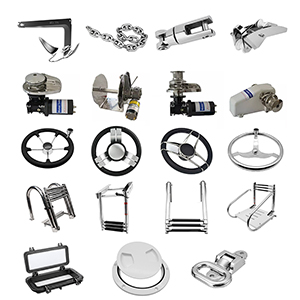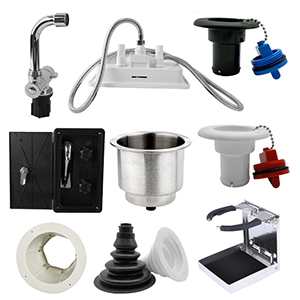When it comes to marine hardware, it's crucial to ensure that all components are in optimal working condition for smooth sailing and safe navigation. However, like any mechanical system, marine hardware can experience common issues that may require troubleshooting and timely repairs. In this article, we will delve into some of the most prevalent problems encountered with marine hardware and provide practical solutions to fix them.
I. Understanding the Common Issues:
- Corrosion: A Persistent Menace
- Leaky Seacocks: A Cause for Concern
- Loose or Damaged Rigging: A Safety Hazard
- Electrical Malfunctions: A Power Struggle
- Outdated or Inadequate Anchoring Systems: A Holding Challenge
- Friction and Wear: Parts in Motion
- Plumbing Problems: Managing Water Flow
II. Troubleshooting Marine Hardware Issues:
1、Corrosion: A Persistent Menace
Corrosion is a common challenge faced by marine hardware, owing to the harsh saltwater environment. Saltwater acts as an electrolyte, accelerating the corrosion process. To tackle this issue:
- Regularly inspect and clean all metal components, ensuring any signs of corrosion are addressed promptly.
- Apply protective coatings, such as anti-corrosion sprays or paints, to metal surfaces.
- Consider using sacrificial anodes to divert corrosion away from critical components.
2、Leaky Seacocks: A Cause for Concern
Seacocks are vital for controlling water flow into and out of the boat. A leaky seacock can lead to flooding and compromise the vessel's stability. Here's how to troubleshoot this issue:
- Inspect the seacock for any visible cracks or damage. Replace if necessary.
- Check the valve handle for smooth operation and ensure it is fully closed when not in use.
- Apply a marine sealant around the seacock to prevent leaks.
3、Loose or Damaged Rigging: A Safety Hazard
Rigging plays a crucial role in supporting the mast and sails, ensuring the vessel maintains its desired course. Loose or damaged rigging can pose a significant safety risk. To address this issue:
- Conduct regular inspections of the rigging, looking for signs of wear, fraying, or loose connections.
- Replace any worn or damaged rigging components promptly.
- Properly tension the rigging to ensure optimal performance.
4、Electrical Malfunctions: A Power Struggle
Electrical systems on a boat are critical for various operations, including navigation, lighting, and communication. Addressing electrical malfunctions requires a systematic approach:
- Inspect all electrical connections, ensuring they are clean and tight.
- Test batteries regularly and replace them when necessary.
- Troubleshoot specific electrical components using a multimeter and consult an expert if needed.
5、Outdated or Inadequate Anchoring Systems: A Holding Challenge
An effective anchoring system is essential for a boat's stability, especially during rough weather or when mooring. To troubleshoot anchoring issues:
- Assess the anchor and chain for signs of wear or damage, replacing them if necessary.
- Upgrade to a larger, more suitable anchor and chain size if the current setup is inadequate for your boat's size and conditions.
- Familiarize yourself with proper anchoring techniques and ensure the anchor is properly set.
6、Friction and Wear: Parts in Motion
Moving parts in marine hardware, such as winches, blocks, and steering systems, are susceptible to friction and wear over time. Regular maintenance is key to troubleshooting this issue:
- Clean and lubricate moving parts regularly, using marine-grade lubricants.
- Inspect these components for signs of wear, replacing or repairing as needed.
- Follow manufacturers' guidelines for proper maintenance and servicing of specific hardware.
7、Plumbing Problems: Managing Water Flow
Proper plumbing is crucial for the functioning of onboard systems, such as freshwater supply, sanitation, and bilge pumping. Troubleshooting plumbing issues involves the following steps:
- Inspect all plumbing connections for leaks, ensuring they are properly tightened or replaced.
- Clear any clogs in the plumbing system using appropriate tools.
- Regularly clean and maintain pumps and filters to ensure optimal water flow.
Conclusion:
As a responsible boat owner, staying vigilant and addressing common marine hardware issues is essential for the safety and longevity of your vessel. By understanding these issues and following the troubleshooting steps provided, you can ensure smooth sailing and enjoy your time on the water without unnecessary complications. Remember, regular maintenance and prompt repairs are key to a well-functioning marine hardware system.
Post time: Jul-20-2023




